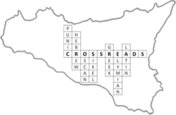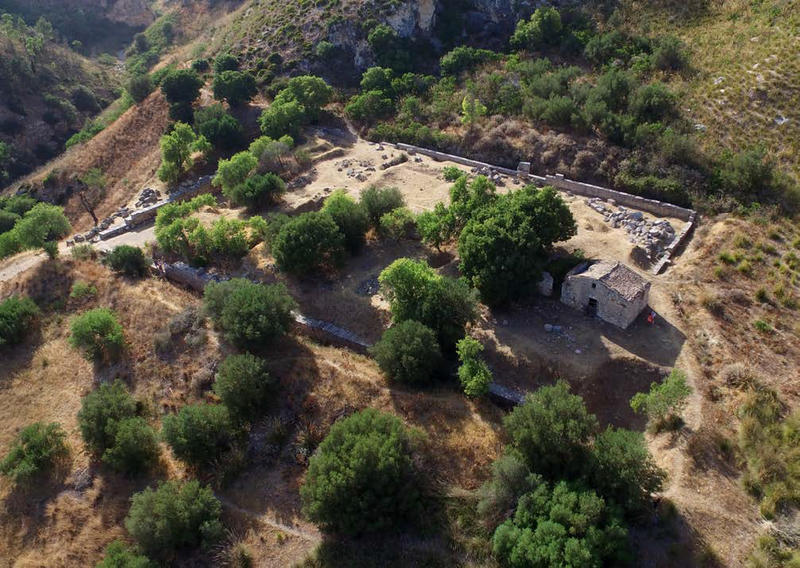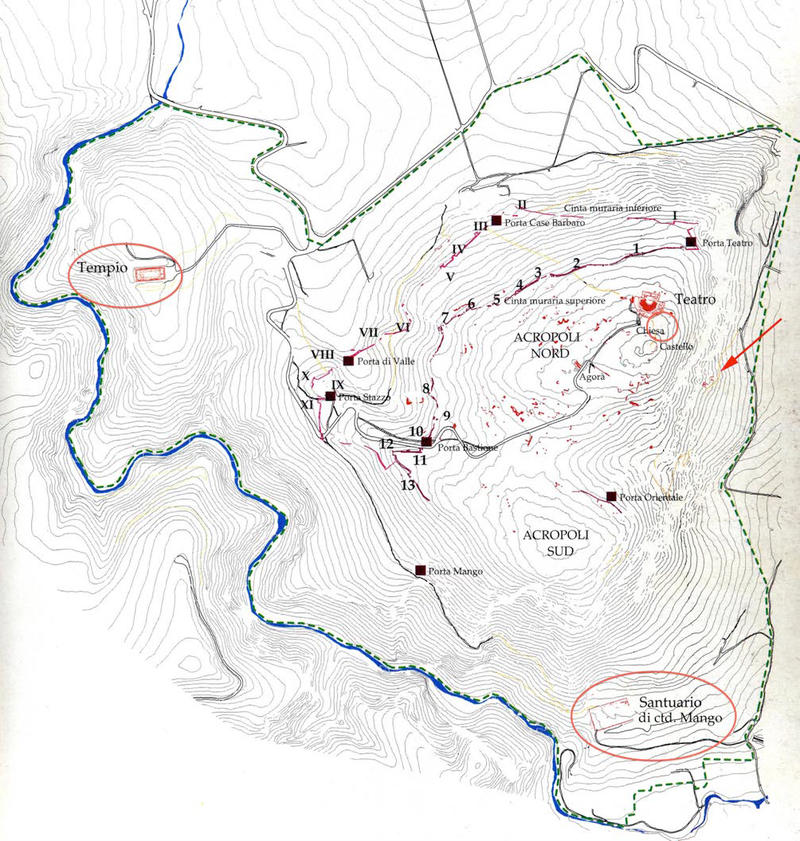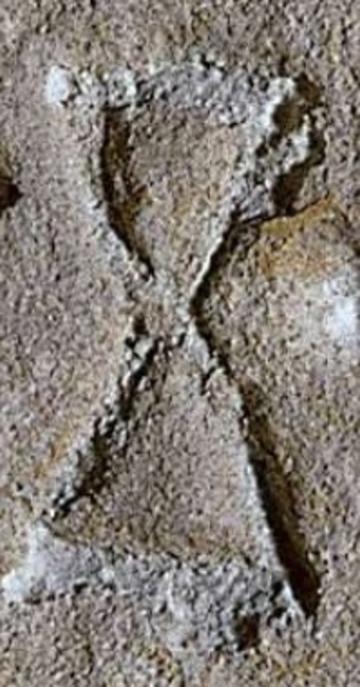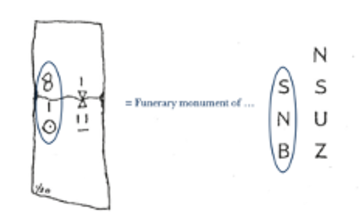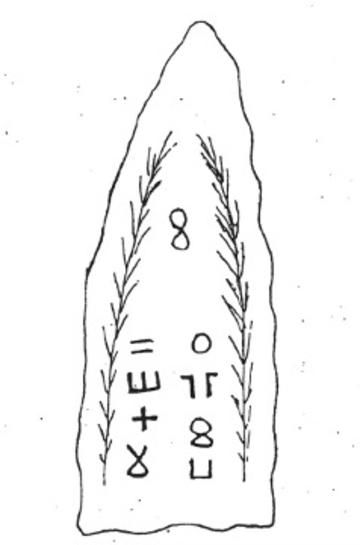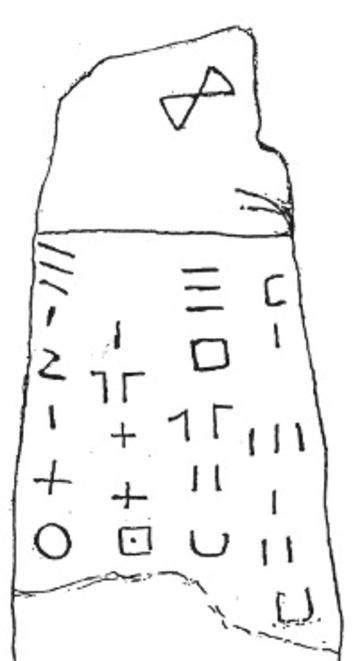A new language in the epigraphic landscape of ancient Sicily
Phoenician, Punic, Elymian, Sikel, Greek, Oscan, Latin, Hebrew. This is our starting list of languages attested in the epigraphic evidence of ancient Sicily. We must now add a new language. This is the Libyan-Berber language, or rather the eastern dialect of this language, which seems to be traceable in some of the numerous inscriptions found in the Elymian site of Segesta, in the ancient waste dump of Grotta Vanella (de Cesare, and Serra, 2012). Situated on the high ground of Monte Barbaro, a few kilometres from the ancient Greek polis of Selinunte and the Phoenician city of Panormos (modern Palermo, fig.1), Segesta was one of the most important indigenous settlements in western Sicily – i.e. Elymian Sicily, according to the traditional division of indigenous Sicily into Elymian, Sikel and Sikan.
When you walk up the steep road to one of the two summits of Mount Barbaro today, you can immediately appreciate the significance of the site: despite the fact that only ruins remain, the imposing (albeit incomplete) Doric-style temple, the theatre and what remains of the bouleuterion and the agora (dating from the site’s most monumental phase, in the late Hellenistic period) they create the outline of once flourishing and populous polis (for a virtual tour of the Segesta archaeological park see Parco di Segesta). In the late archaic period this centre already boasted two or perhaps three sacred areas: the sanctuary at Contrada Mango (fig. 2), a temple whose foundations were found near the area of the bouleuterion, and a third sanctuary area located on the northern acropolis (fig. 3). Today, nothing remains of the latter, except for a huge dump of objects that were probably used for worshipping deities and which were thrown down the hill during a subsequent phase of reconstruction into the recess known today as ‘Grotta Vanella’.
The sanctuary in question probably consisted of an open space on which wooden structures stood (see De Vido, forthcoming), this was one of the most important cultic centres of Late Archaic Sicily. It was possibly intended to host several deities and certainly a goddess, judging by the large proportion of material relating to the female sphere that have been retrieved from the dump (e.g. loom weights, one of which is even inscribed: cf. Agostiniani, de Cesare, Enegren Landenius, 2014). Out of some 30,000 fragments of vessels (mostly imported) and other material remains (bone, bronze and terracotta figurines) approximately 442 inscriptions were found, most of which were published in the late 1970s by Luciano Agostiniani (Iscrizioni anelleniche di Sicilia, vol.1). Most of these epigraphic documents are highly fragmentary - with the exception of a single intact vase (ISic020283). They consist of graffiti incised after firing on black-figure Attic pottery, or on local pottery (in smaller numbers) and can be dated between the end of the 6th and the beginning of the 5th century BC (on the pottery and dating, see Marchesini, 2012). Agostiniani assumed that most of the texts are in Elymian, an Italic language also attested in other centres of western Sicily, while some may be in Greek. However, these documents are often so fragmentary (fig. 4) that it is difficult to determine their linguistic identity. While surveying the graffiti in order to collect them in the ISicily corpus - in which they now appear as drafts - a couple of fragments in particular attracted my attention: ISic020288 (fig. 5) and 020307 (fig. 6), both because they were evidently engraved by the same hand and because of the hourglass grapheme above the rest of the inscription in ISic020307.
Recently, I came across the inscriptions from Grotta Regina, a cave above Mondello beach near Palermo where, according to the text of the inscriptions, there was a Punic sanctuary dedicated to chthonian and fertility deities. Among the Punic and Neo-Punic inscriptions found in the cave, Bishop Benedetto Rocco identified several Libyan inscriptions, probably dating from the middle of the 3rd century BC (Rocco, 1974); these merit a thorough re-investigation. Prompted by what was only my own initial speculative idea, I learned that in 1969 Michel Lejeune (Lejeune, 1969) had already hypothesised a Libyan origin for these two ‘Elymian’ inscriptions: in particular, he suggested they referenced two Libyan names transcribed in Greek characters (the first is not epigraphically attested but can be ascribed to Libyan-Berber onomastics; the other is known). In more recent years, René Rebuffat (Rebuffat, 2008) confirmed Lejeune’s hypothesis, contributing new evidence for this line of inquiry by reading other fragments from Grotta Vanella as probably Libyan. In short, what most attracted the attention of Lejeune, and later of Rebuffat, and what attracts mine today is the grapheme which in Libyan has the value of ‘S’ (the so-called hourglass, a sign little known in Sicilian epigraphy and not otherwise interpreted in Elymian epigraphy, fig. 7) and which has a function similar to the genitive of possession within the text and/or to an ownership mark when found in isolation. With the former function, it often featrures on funerary stelae, for example, together with the noun BN-S = ‘tomb, funerary monument of’ (fig. 8) or W-S = ‘son of’ or MT-S = ‘burial of’. As an ownership mark for a specific person, it appears in isolation, surmounting the stele (figs. 9-10), as if to indicate that the stele belongs to the deceased mentioned in the text of the epigraph. The same value, particularly in the presence of a Libyan name, seems to be ascribed to the ‘hourglass’ symbol which is found above the name incised on ISic020307 (fig. 6). Were this to be confirmed, both the name and the use of the hourglass sign would point towards the eastern Libyan dialect, from the area of Tunisia and north-eastern Algeria (fig. 11).
Could it be that two Libyan dedicators had the text written by the same officiant? Is this an isolated case, or are there other texts in the same language at Segesta and elsewhere in Sicily? And who were these Libyans: slaves, mercenaries (perhaps of Hamilcar defeated at Himera?), adventurers (a category often underestimated in long-distance mobility), or merchants? And which deity(ies) did they worship on the northern acropolis of Segesta? All these questions - or at least some of them - will be answered in a forthcoming article. What is certain is that we should not be surprised to find evidence of other North African presences (not simply Phoenician-Punic ones) in Sicily during the archaic and late archaic periods, and especially in the western part of the island, so closely connected to African routes. North of Africa was populated by many different peoples, some of whom are mentioned in Greek literary sources (see e.g. Herodotus’ Libyan accounts in 4.167-181 in which he names the Adyrmachidae, Giligamae, Asbystae, Auschisae, Bacales, Nasamones, Psylloi, Garamantes, Macae, Gindanes, Lotophagoi, Machlyes, Ausees as the nomadic Libyans who lived on the coast; see also Diod.Sic. 3.49.1). It was a land only partly under the rule of Carthage – and one which, moreover, brought together culturally and linguistically diverse populations.
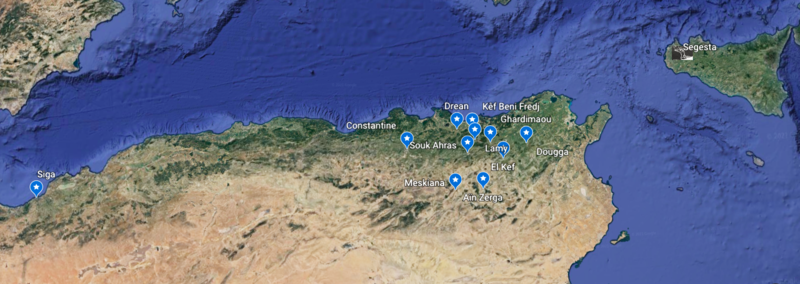
Fig. 11. Main sites of discovery of epigraphic evidence in ‘Eastern’ Libyan-Berber.
Although this is evident from a historical point of view - just as it is evident that Sicily was not only populated by Greeks - we unconsciously tend to favour the history of what is better ‘known’, forgetting the great cultural and linguistic wealth that must have characterised this part of the Mediterranean and associating, in an interpretative short-circuit, all of North Africa with Carthage alone. These tantalising hints from ‘Elymian’ Segesta serve as a timely reminder to question such assumptions and simplistic readings. This brief excursion to the corner of Sicily closest to Africa began with two damaged fragments of inscribed pottery found in a secondary deposition on the slopes of a mountain that was home to an important Elymian centre. The detailed analysis of these two texts has opened up a scene of mobility, exchange and mutual influence previously underestimated for the historical period in question. I have a hunch that we will find other languages here, and certainly other stories to tell...
Fenicio, Punico, Elimo, Siculo, Greco, Osco, Latino, Ebraico. Questa è la nostra lista di partenza delle lingue attestate dall’epigrafia nella Sicilia antica. A questo già ricco novero oggi dobbiamo aggiungere una nuova lingua. Si tratta della lingua libico-berbera o – piuttosto – del dialetto orientale di questa lingua che sembra potersi rintracciare in alcune delle numerose iscrizioni rinvenute nella elima Segesta, nel deposito di Grotta Vanella (sul deposito De Cesare, and Serra, 2012).
Posta sull’altura del Monte Barbaro, a pochi chilometri dalla polis di Selinunte e dalla fenicia Panormo (moderna Palermo, fig. 1), Segesta è stato uno dei più importanti insediamenti indigeni della Sicilia occidentale – la Sicilia elima, stando alla tradizionale divisione della Sicilia indigena in elima sicana e sicula.
Quando oggi si percorre la ripida strada che porta su una delle due sommità del Monte Barbaro ci si accorge subito della rilevanza del sito: nonostante ne siano visibili infatti solo le rovine, l’imponente (ma mai terminato) tempio in stile dorico, il teatro e ciò che rimane del bouleuterion e dell’agora – risalenti alla fase di maggiore monumentalizzazione del sito, avvenuta nella tarda età ellenistica – si mostrano come lo scheletro urbanistico di una polis fiorente e popolosa (per una passeggiata virtuale del parco archeologico di Segesta: Parco di Segesta). In età tardo arcaica questo centro godeva già di due o forse tre aree sacre: il santuario presso Contrada Mango (fig. 2), un tempio le cui fondazioni sono state rinvenute nei pressi dell’area del bouleuterion e una terza area santuariale posta sull’acropoli nord (fig. 3). Di quest’ultima oggi non resta nulla se non un enorme scarico di oggetti probabilmente preposti al culto e gettati, in una fase di rifacimento dell’acropoli, sulle pendici del Monte, nel recesso denominato oggi ‘Grotta Vanella’.Probabilmente consistente in uno spazio aperto sul quale insistevano strutture lignee (vd. De Vido, c.d.s.), l’area in questione doveva essere uno dei più importanti centri cultuali della Sicilia tardo arcaica, preposto forse ad accogliere più divinità e certamente una divinità femminile, stando all’ampio campione di materiale relativo alla sfera femminile che lo scarico ha restituito (cf. Agostiniani, de Cesare, Enegren Landenius, 2014). Su ben 30.000 frammenti di vasi (soprattutto di importazione) e altro materiale (oggetti in osso, bronzo e figurine in terracotta) sono state rinvenute circa 442 iscrizioni, per la maggior parte pubblicate alla fine degli anni Settanta da Luciano Agostiniani (Iscrizioni anelleniche di Sicilia, vol.1). I documenti epigrafici, tutti molto frammentari – con l’eccezione di un unico vaso integro (ISic020283) – consistono in graffiti (effettuati dopo la cottura) su ceramica attica a figure nere o su ceramica locale (in minor numero) e sono databili tra la fine del VI secolo e l’inizio del V a.C. (sui supporti e la datazione Marchesini, 2012). Agostiniani ha ipotizzato che la maggior parte dei testi siano in lingua elima, una lingua italica attestata anche in altri centri della Sicilia occidentale, mentre alcuni di essi potrebbero essere in greco. Si tratta tuttavia di documenti talvolta talmente frammentari (fig. 4) che risulta difficile spesso determinarne la pertinenza linguistica.
Nel corso del censimento dei graffiti all’interno del corpus di ISicily - nel quale adesso si trovano in formato di bozza – ristudiando questi frammenti alcuni in particolare hanno attratto la mia attenzione, ISic020288 (fig. 5) e 020307 (fig. 6), sia perché sono evidentemente stati incisi dalla stessa mano, sia per il grafema che sormonta l’iscrizione in ISic020307. Mi ero infatti di recente imbattuta nelle iscrizioni di Grotta Regina, una grotta che sovrasta la spiaggia di Mondello e nella quale probabilmente si trovava un santuario punico preposto, stando al testo delle iscrizioni rinvenute, al culto di divinità ctonie e legate alla fertilità. Tra le iscrizioni puniche e neopuniche rinvenute nella grotta Monsignor Benedetto Rocco aveva individuato delle iscrizioni libiche, probabilmente risalenti alla metà del III sec. a.C. (Rocco, 1974) sulle quali tuttavia servirebbe oggi un’indagine più approfondita. Mossa da quella che era solo una mia iniziale speculazione ho appreso che già Michel Lejeune nel 1969 (Lejeune, 1969) aveva ipotizzato un’origine libica per le due iscrizioni: si tratterebbe, in particolare, di due nomi libici (il primo non attestato epigraficamente ma ascrivibile all’onomastica libico-berbera e l’altro invece noto) trascritti in caratteri greci. In anni più recenti René Rebuffat (Rebuffat, 2008) ha confermato l’ipotesi di Lejeune aggiungendo nuovi elementi probanti all’indagine e leggendo come probabilmente libici altri frammenti provenienti da Grotta Vanella. In breve, quello che più attrasse l’attenzione di Lejeune, e poi di Rebuffat e che attrae la mia oggi è il grafema che in libico ha valore di ‘S’ (la cosiddetta clessidra, segno poco noto nell’epigrafia siciliana e non interpretato in quella elima, fig. 7) e che ha una funzione simile al genitivo di possesso all’interno del testo e/o a un segno di appartenenza se si trova isolato. Con la prima funzione appare ad esempio molto spesso nelle stele funerarie insieme al nesso BN-S = ‘tomba, monumento funebre di’ (fig. 8) o W-S = ‘figlio di’ o ancora MT-S = ‘sepoltura di’. Con il valore di segno di appartenenza a una data persona appare invece isolato, sormontante la stele (fig. 9-10), come se indicasse che la stele è del defunto riportato nel testo dell’epigrafe. Lo stesso valore, tanto più in presenza di un nome libico, sembra potersi ascrivere alla ‘clessidra’ che si trova sopra il nome citato, graffito in ISic020307 (fig. 6). Se così fosse sia il nome che l’uso del segno a clessidra indirizzerebbero verso il dialetto libico orientale, dell’area della Tunisia e del nord est dell’Algeria (fig. 11). Che si tratti allora di due dedicanti libici che si fecero redigere il testo da uno stesso officiante? Si tratta di un caso isolato o ci sono altri testi ascrivibili alla stessa lingua a Segesta e altrove in Sicilia? E chi erano questi libici: schiavi, mercenari (dell’Amilcare sconfitto a Imera?), avventurieri (categoria spesso sottovalutata nella mobilità a lungo raggio), mercanti? E quale/i divinità si officiavano sull’acropoli nord di Segesta? A tutte queste domande – o piuttosto ad alcune di esse – fornirò una risposta in un articolo di prossima pubblicazione. Certo è che non dovremmo sorprenderci di trovare indizi di frequentazioni nordafricane altre rispetto a quelle fenicio-puniche in Sicilia in età arcaica e tardo-arcaica, per di più nella parte occidentale dell’isola così vicina e intrecciata alle rotte africane. L’area settentrionale dell’Africa allora, popolata da genti diverse, nominate anche dalle fonti letterarie greche (si veda ad esempio il resoconto libico in Hdt. 4.167-181 in cui troviamo un vasto campionario di popolazioni - Adyrmachidai, Giligamai, Asbystai, Auschisai, Bacales, Nasamones, Psylloi, Garamantes, Macai, Gindanes, Lotofagoi, Machlyes, Ausees – elencate come nomadi della fascia costiera; o ancora, tra gli altri, Diod.Sic. 3.49.1) era una terra solo in parte sotto il dominio di Cartagine – che del resto aggiogò sotto di sé popolazioni culturalmente e anche linguisticamente diverse. Per quanto questo sia evidente dal punto di vista storico – com’è evidente che la Sicilia non era popolata solo da Greci – tendiamo inconsapevolmente a privilegiare la Storia dei più ‘noti’ dimenticando la grande ricchezza culturale e linguistica che doveva caratterizzare questa parte di Mediterraneo e associando, come in un corto circuito interpretativo, tutta l’Africa settentrionale alla sola Cartagine.

Fig. 11. Principali siti di rinvenimento di iscrizioni in libico-berbero ‘orientale’.
Questa breve storia su un angolo della Sicilia, sulla quale c’è molto da raccontare, è cominciata da due malridotti frammenti di ceramica iscritta trovati in deposizione secondaria sulle pendici di un monte su cui fiorì un importante centro elimo. L’analisi particolareggiata di questi due testi ha aperto una prospettiva di scambi mobilità e reciproche influenze che prima sottovalutavamo per il periodo storico in questione. La mia ipotesi oggi è che troveremo altre lingue e certamente altre storie da raccontarvi molto presto…
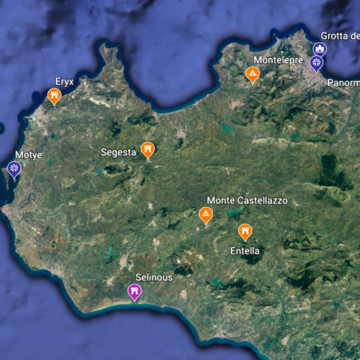
Fig. 1. Main centres in western Sicily in the late archaic period.

